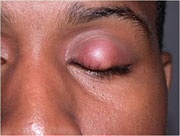What is a Stye?
A stye (also called a hordeolum) is a small, red, painful lump that grows from the base of your eyelash or under the eyelid. Most styes are caused by a bacterial infection.
There are two kinds of styes:
- External hordeolum: A stye that begins at the base of your eyelash. Most are caused by an infection in the hair follicle. It might look like a pimple.
- Internal hordeolum: A stye inside your eyelid. Most are caused by an infection in an oil-producing gland in your eyelid.
You can also get a stye if you have blepharitis. This is a condition that makes your eyelids at the base of the eyelashes red and swollen.
When you first get a stye, your eyelid is probably red and tender to the touch. Your eye may also feel sore and scratchy.
What is a chalazion?
A chalazion is a swollen bump on the eyelid. It happens when the eyelid’s oil gland clogs up. It may start as an internal hordeolum (stye). At first, you might not know you have a chalazion as there is little or no pain. But as it grows, your eyelid may get red, swollen, and sometimes tender to touch. If the chalazion gets large, it can press on your eye and cause blurry vision. Rarely, the whole eyelid might swell.

A stye is a red, sore lump near

A chalazion is an enlargement of
an oil-producing gland in the
eyelid.
What is the difference between a stye and a chalazion?
Sometimes it can be difficult to tell the difference between a stye and a chalazion.
A stye is very painful. It often appears at the eyelid’s edge, usually caused by an infected eyelash root. It often swells, sometimes affecting the entire eyelid.
A chalazion is not usually painful. It is a bump that usually develops farther back on the eyelid than a stye. It is caused by a clogged oil gland. Rarely does it make the entire eyelid swell.
Stye symptoms can include:
- a very painful red bump along the edge of the eyelid at the base of the eyelashes. It may make the entire eyelid swell
- usually a small pus spot at the center of the bump
- feeling like something is in your eye
- having a scratchy feeling in the eye
- being sensitive to light
- crustiness along the eyelid margin
- tearing in that eye
A chalazion can develop and you might not see any symptoms. When there are symptoms, they can include:
- a bump on the eyelid, sometimes becoming red and swollen. Occasionally it can be tender.
- rarely, an entirely swollen eyelid
- blurry vision, if the chalazion is large enough to press on the eyeball
Anyone can get a stye or chalazion. But you are even more likely to get one if you have:
- Blepharitis, a problem that affects the edge of your eyelid
- Had a stye or chalazion before
- A skin condition, such as acne rosacea or seborrheic dermatitis
- Diabetes or other medical problems*
Treatment
Dr. Banik initially recommends conservative therapy for styes and chalazia with warm compresses, gentle eyelid massage, and lid scrubs twice a day. These treatments help promote drainage of blocked eyelid glands. For warm compresses, she prefers the patented Bruder® moist heat compress twice a day, as it retains heat very well.
Antibiotics do not tend to work very well for styes or chalazia, unles the entire eyelid becomes swollen and infected.
Most eyelid bumps resolve over time, but can take 4-6 weeks to drain fully. Rarely, patients require surgical drainage.
Also, be sure not to squeeze or try to pop a stye or chalazion. Doing so could spread the infection into your eyelid. Do not wear eye makeup or contact lenses while you have a stye or chalazion.
It is now possible to image the glands within your eyelids using state-of-the-art technology called LipiScan®. If you have stubborn or recurrent eyelid bumps, Dr. Banik uses LipiScan® imaging of the eyelid glands to determine the best treatment for your eyelid issue.
*Adapted from www.aao.org
